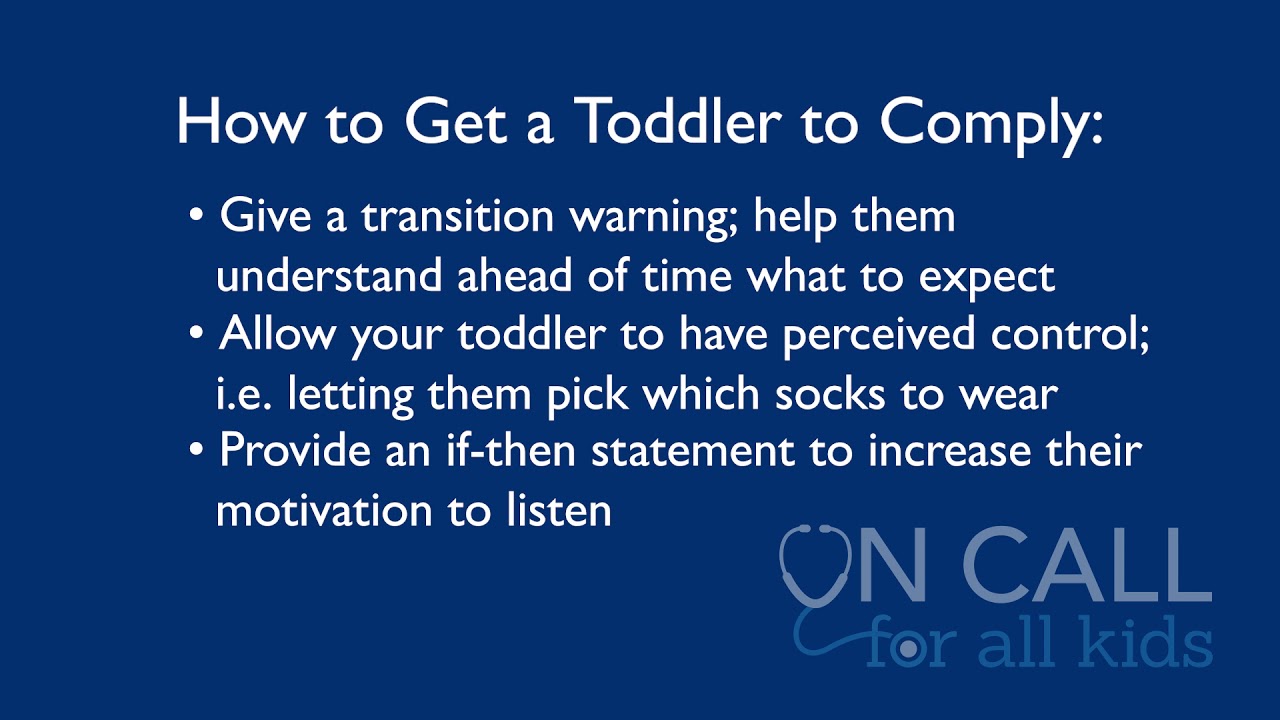Why won’t my toddler listen? Toddlers often don’t listen because their brains are still developing, they’re exploring their independence, and they’re learning to test boundaries. This article will explore practical and proven strategies to improve communication with toddlers and foster toddler obedience using positive parenting techniques and effective toddler behavior management. We’ll delve into setting boundaries for toddlers, appropriate consequences for toddlers, and how to navigate toddler tantrums effectively. Forget power struggles – let’s build cooperation!

Image Source: www.hopkinsmedicine.org
The Toddler Listening Labyrinth: Decoding the “Why”
Before diving into solutions, it’s vital to grasp why toddlers sometimes seem to have selective hearing. It’s not always defiance; often, it’s a matter of developmental stage.
Decoding Toddler Behavior
- Limited Attention Spans: Toddlers live in the “now.” Their attention flits from one exciting thing to another. Expecting them to focus for extended periods is unrealistic.
- Developing Language Skills: They may not fully comprehend what you’re asking. Their receptive language (what they understand) is often greater than their expressive language (what they can say).
- The Quest for Independence: “Me do it!” is a common toddler mantra. They crave autonomy and control, leading to resistance when told what to do.
- Emotional Regulation: Big feelings overwhelm little people. When upset, reasoned requests are unlikely to be heard, much less obeyed.
- Testing Boundaries: Toddlers explore the world by pushing limits. It’s how they learn cause and effect and where the lines are drawn. This falls under the umbrella of understanding toddler behavior.
- Physical Needs: Hunger, tiredness, or discomfort can dramatically impact cooperation. A cranky toddler is often a toddler with unmet needs.
The Pitfalls of Traditional Toddler Discipline
Many traditional discipline methods backfire, leading to more resistance and strained relationships.
- Yelling: While it might get immediate compliance, yelling increases fear and anxiety, damaging trust and potentially leading to aggression.
- Punishment-Focused Approaches: Relying solely on time-outs or taking away toys can create resentment and doesn’t teach positive behavior.
- Inconsistent Rules: Shifting rules confuse toddlers. They need clear, consistent boundaries to feel secure and understand expectations.
- Ignoring Positive Behavior: Focusing only on what’s wrong misses opportunities to reinforce good choices and foster intrinsic motivation. This is where positive parenting techniques come in handy.
Cracking the Code: Effective Strategies for Getting Your Toddler to Listen
These strategies, rooted in effective parenting strategies, focus on connection, communication, and consistency.
1. Master the Art of Connection Before Correction
Building a strong bond is the foundation for cooperation.
- Spend Quality Time: Even 15 minutes of undivided attention can make a difference. Play, read, or simply cuddle.
- Listen Actively: Get down to their level, make eye contact, and truly listen to what they’re saying (or trying to say). Acknowledge their feelings.
- Show Empathy: “I see you’re frustrated because you can’t reach the toy.” Validating their emotions helps them feel understood.
- Use Positive Reinforcement: Catch them being good! Praise specific behaviors you want to see repeated. “I love how you helped put your toys away!”
- Limit Screen Time: Excessive screen time can negatively impact attention spans and behavior.
2. Communication is Key
Clear, simple communication is essential.
- Get Their Attention First: Say their name, touch their shoulder gently, or use a playful tone to gain focus before giving instructions.
- Speak Clearly and Simply: Use short, easy-to-understand sentences. Avoid complex language or abstract concepts. “Please put the truck on the shelf” is better than “Could you tidy up your toys, please?”
- Give One Instruction at a Time: Overloading them with multiple requests sets them up for failure.
- Use Visual Aids: Pictures, gestures, and demonstrations can enhance comprehension, especially for younger toddlers. Show them what you want them to do.
- Make it Fun: Turn tasks into games. “Let’s see if we can put all the blocks in the box before the timer goes off!”
3. Setting Boundaries: The Foundation of Security
Clear boundaries provide structure and help toddlers feel safe and secure. This is a core aspect of setting boundaries for toddlers.
- Establish Clear Rules: Keep rules simple, consistent, and age-appropriate. Focus on essential boundaries like safety, respect, and kindness.
- Communicate Boundaries Clearly: Explain the rules in simple terms. “We don’t hit because it hurts people.”
- Be Consistent: Enforce boundaries consistently. Inconsistency creates confusion and undermines your authority.
- Offer Choices (When Possible): Giving limited choices empowers toddlers and reduces resistance. “Do you want to wear the blue shirt or the red shirt?”
- Prepare Them for Transitions: Toddlers often struggle with transitions. Give them advance warning. “In five minutes, we’re going to stop playing and get ready for dinner.”
4. Navigating Toddler Tantrums: A Survival Guide
Tantrums are a normal part of toddler development. How you respond can significantly impact their frequency and intensity. Understanding what triggers them helps you develop good toddler behavior management.
- Stay Calm: Your calmness is contagious. If you lose your cool, the situation will escalate.
- Ensure Safety: Make sure your child is safe and can’t hurt themselves or others.
- Ignore the Behavior (When Appropriate): If the tantrum is attention-seeking and your child is safe, ignore the behavior. Don’t engage or give in to their demands.
- Offer Comfort: Once the tantrum subsides, offer comfort and reassurance. “I know you were upset, but I’m here for you.”
- Teach Emotional Regulation: Help your child learn to identify and manage their emotions. Talk about feelings and provide healthy coping strategies like deep breathing or taking a break.
- Identify Triggers: Try to determine what triggers tantrums. Are they tired, hungry, or overwhelmed? Knowing the triggers allows you to prevent some tantrums.
5. Consequences: Teaching Cause and Effect
Consequences are a tool to teach cause and effect, not punishment. The effectiveness of your consequences for toddlers depends on how you apply them.
- Natural Consequences: Allowing natural consequences to occur (within safe limits) is a powerful teaching tool. If they refuse to wear a coat, they may get cold.
- Logical Consequences: Consequences that are logically related to the behavior. If they throw toys, the toys are taken away for a short period.
- Time-Outs (Used Sparingly): Time-outs can be effective, but they should be brief (one minute per year of age) and used as a calming break, not a punishment. Focus on helping the child calm down and reflect on their behavior.
- Avoid Physical Punishment: Spanking or other forms of physical punishment are harmful and ineffective. They teach aggression and fear, not respect or cooperation.
- Focus on Repair: After a consequence, focus on repairing the relationship and teaching alternative behaviors.
6. Consistency is Your Superpower
Consistency is paramount. It provides predictability and helps toddlers learn expectations.
- Be a United Front: Parents and caregivers should agree on rules and consequences and enforce them consistently.
- Review and Adjust: Toddlers’ needs and abilities change rapidly. Regularly review your strategies and adjust them as needed.
- Be Patient: It takes time and repetition for toddlers to learn new behaviors. Don’t get discouraged by setbacks.
- Celebrate Successes: Acknowledge and celebrate progress, no matter how small. Positive reinforcement is a powerful motivator.
Table: Toddler Listening Strategies Cheat Sheet
| Strategy | Description | Example |
|---|---|---|
| Connection Before Correction | Build a strong bond through quality time, active listening, and empathy. | Spend 15 minutes playing their favorite game without distractions. |
| Clear Communication | Use simple language, give one instruction at a time, and use visual aids. | Instead of “Clean up this mess,” say “Please put the blocks in the box.” Show them the box and where to put the blocks. |
| Setting Boundaries | Establish clear, consistent rules and communicate them effectively. | “We don’t hit. Hitting hurts.” |
| Navigating Tantrums | Stay calm, ensure safety, and ignore attention-seeking behavior. Offer comfort when the tantrum subsides. | During a tantrum, move anything breakable out of reach. Once they’ve calmed down, hug them and say, “It’s okay to be upset.” |
| Consequences | Use natural and logical consequences to teach cause and effect. Avoid physical punishment. | If they throw food, take the food away. |
| Consistency | Enforce rules and consequences consistently. | Always follow through with consequences. If you say you’ll take away a toy, do it. |
The Long Game: Fostering Cooperation, Not Just Compliance
The goal isn’t just to get your toddler to listen in the moment, but to foster cooperation, respect, and self-regulation in the long run. Toddler discipline is about more than just immediate obedience.
- Model Desired Behavior: Be the person you want your child to be. Show respect, listen attentively, and manage your own emotions effectively.
- Teach Problem-Solving Skills: Help your child learn to identify problems, brainstorm solutions, and make choices.
- Encourage Independence: Give your child opportunities to make choices and do things for themselves.
- Focus on the Positive: Emphasize good behavior and positive qualities.
- Remember Self-Care: Parenting is challenging. Take care of your own needs so you can be the best parent possible.
Frequently Asked Questions (FAQ)
Q: What if my toddler never listens, no matter what I try?
A: It’s important to rule out any underlying issues. Consult with your pediatrician or a child development specialist to address any potential developmental delays or behavioral concerns.
Q: How do I handle a toddler who constantly says “no?”
A: Turn situations into choices. Instead of saying, “It’s time to take a bath,” ask, “Would you like to take a bath now or in 10 minutes?” This gives them a sense of control and reduces resistance.
Q: Is time-out an effective form of discipline?
A: Time-outs can be effective when used correctly. They should be brief (one minute per year of age), used as a calming break, not a punishment, and followed by a discussion about the behavior.
Q: How do I deal with sibling rivalry?
A: Focus on individual attention for each child, avoid comparisons, and teach them problem-solving skills to resolve conflicts.
Q: When should I seek professional help?
A: Seek professional help if your toddler’s behavior is significantly impacting their daily life, if you’re feeling overwhelmed and unable to manage their behavior, or if you suspect any underlying developmental or emotional issues.

Clark Lubowitz is a parenting expert with over 10 years of experience in toddler care and child development. Holding a degree in Early Childhood Education, he specializes in blending modern technology with parenting, offering expert advice on the best toddler gadgets. Through his work on ToddlerAwesome.com, Clark provides valuable insights to help parents make informed decisions for their little ones.
